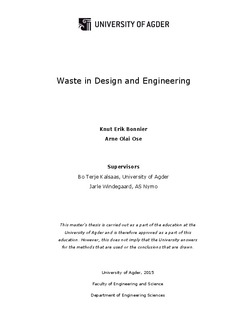| dc.description.abstract | Issues and Purpose
Predictability in design and engineering processes is a significant challenge. It is important to improve predictability since design and engineering processes affects the entire product life-cycle. Increased predictability can render these processes more effective, thus, it is vital to understand the mechanisms that might impact value-creation. This study is part of the Integrated Methodology for Project Management (INPRO) project, which aims to improve planning processes in the construction industry. Consequently, the objective of our study is to identify the mechanisms that may potentially lead to waste in design and engineering. Due to the negative implications that waste in design and engineering might have on down-stream processes this is considered an important area for improvement.
Scope and Limitations
The scope of this study is limited to the conceptualization of waste in design and engineering, with an emphasis on the mechanisms that have the potential to lead to waste. This includes waste which is realized in the design and engineering processes and waste these mechanisms might generate in processes further down-stream. However, elements such as measuring waste and methods for waste reduction are discussed to some extent, but are not the main purpose of this study.
Methods
A constructive research approach was used for this study, which is a method for developing constructions that can contribute to theory in the field of research. This included gathering data from multiple sources, such as literature and a case study. The majority of the source material consisted of literature on topics such as lean, engineering, design, management, and learning. The findings from literature were supplemented with the collected data from the case study. The case company is a supplier for the oil and gas industry. The findings were used to present a general representation of the waste mechanisms in design and engineering, thus, they are meant to be applicable to design and engineering in different industries and organizations.
III
Discussion
In order to conceptualize waste we had to gain some insights into design and engineering. It became apparent that characteristics such as creativity and learning are essential parts of design and engineering, where the process is iterative and explorative, and solutions evolve over time. Simply put, design and engineering can be seen as problem-solving and puzzle-making where the product is information. This is in contrast to conventional production and construction where the product is a physical object. Thus, conceptualizing waste in this context requires a somewhat different approach.
The basis for the conceptualization of waste in this study is the lean philosophy, which has its origins from the Toyota Production System (TPS). Lean facilitates increased value while eliminating waste at the same time. However, previous attempts at conceptualizing waste in design and engineering, to a large extent, involve transposing the seven manufacturing wastes to the area of design and engineering, and often supplementing with additional categories. While several of the wastes from design and engineering can be applied to the manufacturing waste categories, they are often ambiguous. In addition, the manufacturing wastes only consist of seven categories and do not describe the mechanisms that might lead to waste. Thus, it is difficult to identify measures of improvement in relation to mitigating or eliminating waste. Based on these limitations it was decided to approach the problem in a different manner. In order to achieve more predictable and efficient design and engineering processes we created a list of waste drivers. A waste driver in this context is defined as a mechanism that has capacity to create waste and to be hindrances for workflow. Managers, and favorably employees, could benefit from such a list, knowing what contributes to waste will enable people to eliminate it.
Evaluation By creating awareness, the waste drivers enable managers and employees to identify waste related to design and engineering in their organization. Thus, this will contribute to a higher level of predictability and efficiency, which might result in a more profitable operation. However, it is very challenging, or even impossible, to be able to create a list that accounts for all the waste drivers. This is particularly caused by the contextual dependency of the waste drivers. However, all the findings from the case study were compatible with the list of drivers. This suggests that the list of drivers might be applicable for identification of the mechanisms that lead to waste in design and engineering. Consequently, we believe that the waste drivers presented, or a similar system, is currently the most appropriate representation of waste mechanisms in design and engineering. However, there is potential in making the waste drivers more user-friendly. | nb_NO |
